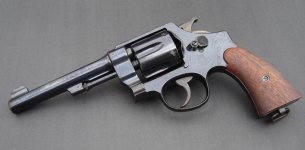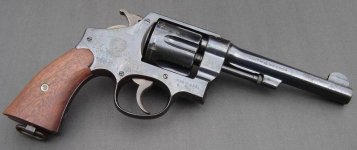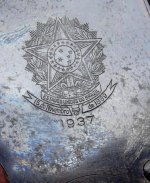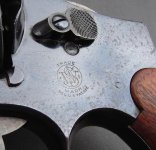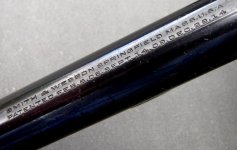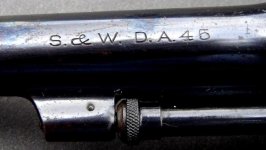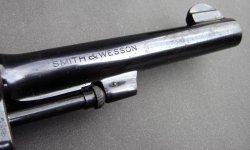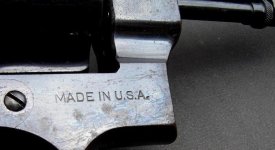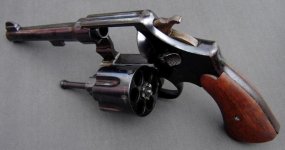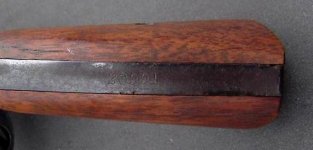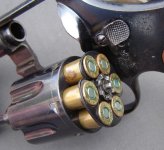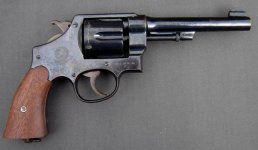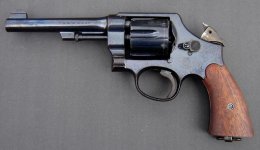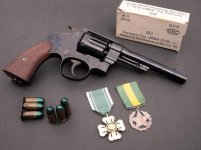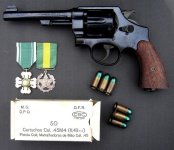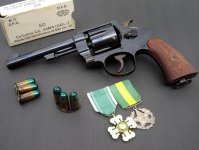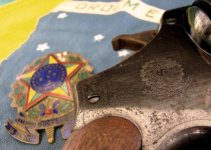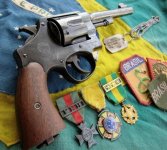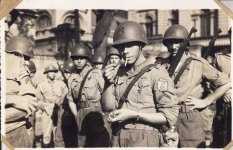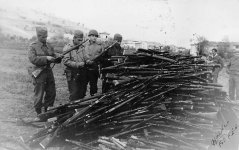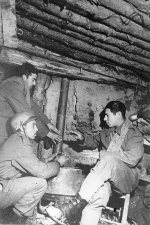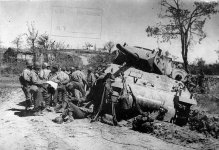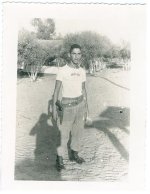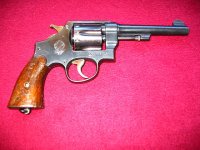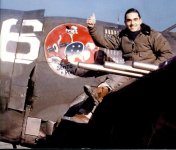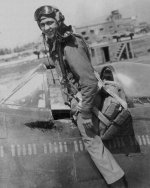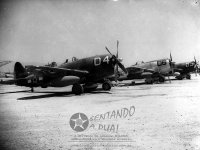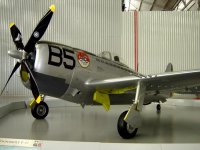Douglas Jr.
Member
Hello all,
I just recently joined the forum, as I'm becoming an adiction S&W revolvers. So, allow me to present you the gun that triggered this new interest.
Here is my Brazilian Contract Smith & Wesson Model 1917 revolver. I know these are not the "big deal" for most of you, but it really enjoyed this one, so allow me to bug you with its historical background.
By 1937 the Brazilian Armed Forces had started a weapons updating program - the first organized process of purchase modern equipment since 1910. In late 1930s, the standard sidearm of the Brazilian Army was the 7,65mm Luger pistol (in its “Model 1906” configuration) but most of the 5000 guns bought in 1908 were already worn out or had been transferred to State Law Enforcements. To make things worse, several minor purchasing of both original as well Spanish copies of Smith & Wesson MP revolvers had been made during the 20s.
Then in late 30s it was decided that, for logistical and strategic matters, the sidearm must be standardized. The Army Ordnance chose the .45 ACP ammo as the new caliber for the Armed Forces and went shopping. An order for 25,000 M1917 revolvers for Smith & Wesson followed (another 25,000 Colts M1911A1 were also bought, but this is another story). The revolver, which was choose also because it was easier to be trained and handle with when compared with semi-autos, was intended to be issued to NCOs and/or rear guard soldiers (MPs, artillery officers, cavalry, etc.). An additional contract of around 12,000 guns was made right after WWII and shipped in 1946.
According to author and researcher Roy Jinks these guns falls in the following serial ranges:
First Brazilian Contract Group (25,000 units), shipped beginning in 1938, serial number range: 181983 to 207043
Second Brazilian Contract Group (12,000 units), shipped beginning in 1946, two serial number ranges: (1) 166,000 to 175150 and (2) 207,196 to 209878.
The “Modelo 1937” revolver is almost a clone of the Smith & Wesson M1917 (“N” frame) that served with the US military in both World Wars, with only few minor changes (such as the rear sight): had plain, smooth wood grips as well as checkered grips with S&W medallion, serrated trigger, a lanyard ring, is marked “Made in USA” on the right side of the frame and “S&W D.A. 45” on the left side of the barrel and fires the 45 ACP using the famous half moon clips. According to a friend who visited S&W plant in early 90s and make contact with their historians, the Brazilian revolvers were assembled with both newly made parts with commercial finishing standards and stocked psrts – and also help S&W finances that were in bad shape at that time. The Brazilian "Modelo 1937" revolvers
In 1944, when the Brazilian Expeditionary Force went to Italy (under the 5th US Army) to fight in WWII, most of its troops were fit after its arriving in Naples (mostly Colt M1911A1 pistols, Springfield M1903 rifles, M3A1 submachine guns and M1 carbines). However, a few hundred of revolvers “Modelo 1937” went with some officers that preferred this kind of weapon instead of the semi-auto pistol (at least one Brazilian general is known to have carried one of these in Italy) and with the Brazilian Military Police staff.
After the war the “Modelo 1937” revolvers stayed in service for three more decades, to be finally withdrawn from use in mid-1970s. My father, who served in an anti-aircraft battery in 1965-1966, remembers to see a few cavalry troops armed with the S&W revolver. Unfortunately for Brazilian collectors, most of the survivors (and there were many) were sold to US Gun Surplus dealers in 1989-1990 and not many have remained down here. But I finally got myself one this year. This one, serial number 200301, came with Pachmayr shooting grips but I managed to find a very nice set of repro grips, thanks to a fellow collector in US.
Hope you enjoyed, remembering that it served my country during one World War and for three more decades after that. It is a loud statement of the fine quality of these guns. And, to remember the 25,000 Brazilian soldiers that also fought against the Nazis in Italy, I made some special photos to celebrate them.
In some of the pictures you can see the "Smoking Snake" patch wore by the Brazilian troops. The story regarding the origin of the phrase about a smoking snake is controversial.
Due to the Brazilian dictatorship's unwillingness to get more deeply involved in the Allied war effort, by 1942 a popular saying was that "it's more likely for snakes to start to smoke now than for the BEF to set out." ("Mais fácil uma cobra fumar do que a FEB embarcar"). Until the BEF entered combat, the expression "a cobra vai fumar" ("snakes will smoke") was often used in Brazil in a context similar to "when pigs fly." As a result, the soldiers of the BEF called themselves Cobras Fumantes (literally, Smoking Snakes), hence the divisional shoulder patch that showed a snake smoking a pipe. After the war the meaning was reversed, signifying that something will definitively happen and in a furious and aggressive way.
This fighting spirit is clearly illustrated by an episode that ocurred near the end of war. During the capture of Montese, three Brazilian soldiers, Arlindo Lúcio da Silva, Geraldo Baeta da Cruz, and Geraldo Rodrigues de Souza, when on a patrol, ran into an entire German Company. Though ordered to surrender, the Brazilians refused and fought to the death. In recognition of their bravery, the Germans would bury them and write on their crosses "Drei brasilianische Helden" (Three Brazilian Heroes). It is also interesting to note that the Brazilian Army was not racial-segregated, which caused some amusement to the Americans from the 5th Army.
For those interested the learn more about the Brazilian Expeditionary Force, I highly recommend the essay "Brazil and World War II: The Forgotten Ally" by Frank D. McCann (New Hapshire University):
EIAL VI2 - Brazil and World War II: The Forgotten Ally.What did you do in the war, Z Carioca?
Sorry for the long post. If is not according to the forum rules, feel free to delete it.
Regards,
Douglas.
I just recently joined the forum, as I'm becoming an adiction S&W revolvers. So, allow me to present you the gun that triggered this new interest.
Here is my Brazilian Contract Smith & Wesson Model 1917 revolver. I know these are not the "big deal" for most of you, but it really enjoyed this one, so allow me to bug you with its historical background.
By 1937 the Brazilian Armed Forces had started a weapons updating program - the first organized process of purchase modern equipment since 1910. In late 1930s, the standard sidearm of the Brazilian Army was the 7,65mm Luger pistol (in its “Model 1906” configuration) but most of the 5000 guns bought in 1908 were already worn out or had been transferred to State Law Enforcements. To make things worse, several minor purchasing of both original as well Spanish copies of Smith & Wesson MP revolvers had been made during the 20s.
Then in late 30s it was decided that, for logistical and strategic matters, the sidearm must be standardized. The Army Ordnance chose the .45 ACP ammo as the new caliber for the Armed Forces and went shopping. An order for 25,000 M1917 revolvers for Smith & Wesson followed (another 25,000 Colts M1911A1 were also bought, but this is another story). The revolver, which was choose also because it was easier to be trained and handle with when compared with semi-autos, was intended to be issued to NCOs and/or rear guard soldiers (MPs, artillery officers, cavalry, etc.). An additional contract of around 12,000 guns was made right after WWII and shipped in 1946.
According to author and researcher Roy Jinks these guns falls in the following serial ranges:
First Brazilian Contract Group (25,000 units), shipped beginning in 1938, serial number range: 181983 to 207043
Second Brazilian Contract Group (12,000 units), shipped beginning in 1946, two serial number ranges: (1) 166,000 to 175150 and (2) 207,196 to 209878.
The “Modelo 1937” revolver is almost a clone of the Smith & Wesson M1917 (“N” frame) that served with the US military in both World Wars, with only few minor changes (such as the rear sight): had plain, smooth wood grips as well as checkered grips with S&W medallion, serrated trigger, a lanyard ring, is marked “Made in USA” on the right side of the frame and “S&W D.A. 45” on the left side of the barrel and fires the 45 ACP using the famous half moon clips. According to a friend who visited S&W plant in early 90s and make contact with their historians, the Brazilian revolvers were assembled with both newly made parts with commercial finishing standards and stocked psrts – and also help S&W finances that were in bad shape at that time. The Brazilian "Modelo 1937" revolvers
In 1944, when the Brazilian Expeditionary Force went to Italy (under the 5th US Army) to fight in WWII, most of its troops were fit after its arriving in Naples (mostly Colt M1911A1 pistols, Springfield M1903 rifles, M3A1 submachine guns and M1 carbines). However, a few hundred of revolvers “Modelo 1937” went with some officers that preferred this kind of weapon instead of the semi-auto pistol (at least one Brazilian general is known to have carried one of these in Italy) and with the Brazilian Military Police staff.
After the war the “Modelo 1937” revolvers stayed in service for three more decades, to be finally withdrawn from use in mid-1970s. My father, who served in an anti-aircraft battery in 1965-1966, remembers to see a few cavalry troops armed with the S&W revolver. Unfortunately for Brazilian collectors, most of the survivors (and there were many) were sold to US Gun Surplus dealers in 1989-1990 and not many have remained down here. But I finally got myself one this year. This one, serial number 200301, came with Pachmayr shooting grips but I managed to find a very nice set of repro grips, thanks to a fellow collector in US.
Hope you enjoyed, remembering that it served my country during one World War and for three more decades after that. It is a loud statement of the fine quality of these guns. And, to remember the 25,000 Brazilian soldiers that also fought against the Nazis in Italy, I made some special photos to celebrate them.
In some of the pictures you can see the "Smoking Snake" patch wore by the Brazilian troops. The story regarding the origin of the phrase about a smoking snake is controversial.
Due to the Brazilian dictatorship's unwillingness to get more deeply involved in the Allied war effort, by 1942 a popular saying was that "it's more likely for snakes to start to smoke now than for the BEF to set out." ("Mais fácil uma cobra fumar do que a FEB embarcar"). Until the BEF entered combat, the expression "a cobra vai fumar" ("snakes will smoke") was often used in Brazil in a context similar to "when pigs fly." As a result, the soldiers of the BEF called themselves Cobras Fumantes (literally, Smoking Snakes), hence the divisional shoulder patch that showed a snake smoking a pipe. After the war the meaning was reversed, signifying that something will definitively happen and in a furious and aggressive way.
This fighting spirit is clearly illustrated by an episode that ocurred near the end of war. During the capture of Montese, three Brazilian soldiers, Arlindo Lúcio da Silva, Geraldo Baeta da Cruz, and Geraldo Rodrigues de Souza, when on a patrol, ran into an entire German Company. Though ordered to surrender, the Brazilians refused and fought to the death. In recognition of their bravery, the Germans would bury them and write on their crosses "Drei brasilianische Helden" (Three Brazilian Heroes). It is also interesting to note that the Brazilian Army was not racial-segregated, which caused some amusement to the Americans from the 5th Army.
For those interested the learn more about the Brazilian Expeditionary Force, I highly recommend the essay "Brazil and World War II: The Forgotten Ally" by Frank D. McCann (New Hapshire University):
EIAL VI2 - Brazil and World War II: The Forgotten Ally.What did you do in the war, Z Carioca?
Sorry for the long post. If is not according to the forum rules, feel free to delete it.
Regards,
Douglas.
Attachments
Last edited:

